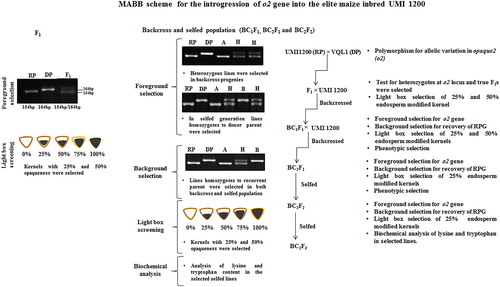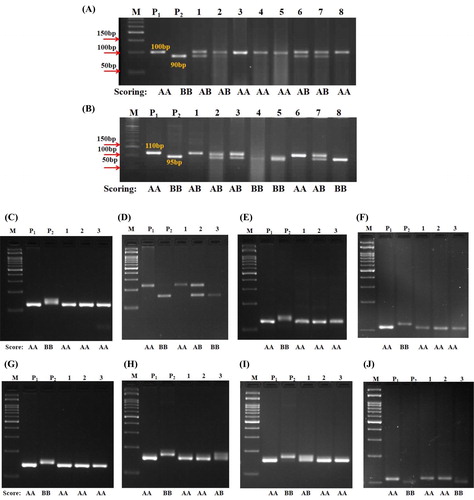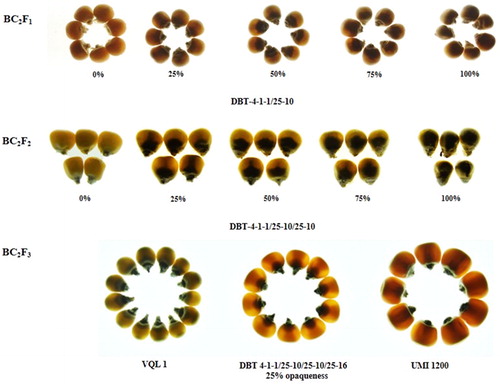Figures & data
Figure 1. General scheme of marker-assisted backcross breeding (MABB) for the conversion of normal maize inbred line UMI 1200 into QPM version using the donor VQL 1. RP: recurrent parent (UMI 1200); DP: donor parent (VQL 1); A: homozygous allele to recurrent; B: homozygous allele to donor; H: heterozygous allele. Three levels of selection were carried out in developing the QPM version of UMI 1200: (i) foreground selection to select the plants with target allele o2; (ii) background selection to recover maximum RPG recovery; (iii) phenotypic selection for agronomic traits and endosperm modification.

Figure 2. Foreground screening of F1, BC1F1, BC2F1 and BC2F2 individuals of UMI 1200 × VQL 1 using umc1066 primer. (A) Foreground selection in F1 individuals; lanes 1–16, F1 progenies. (B) Foreground selection in BC1F1 individuals; lanes 1–16, BC1 F1 progenies. (C) Foreground selection in BC2F1 individuals; lanes 1–17, BC1 F2 progenies. (D) Foreground selection in BC2F2 individuals; lanes 1–17, BC2 F2 progenies. M: 100 bp ladder; P1: UMI 1200; P2: VQL 1.

Table 1. Segregation pattern of the o2 allele in backcross and selfed generations of cross UMI 1200 × VQL 1.
Figure 3. Background selection in selected individuals. Amplification with: umc1710 in BC2F1 (A); umc2101 BC1F1 (B); umc1026 in BC2F2 (C); umc1060 in BC2F2 (D); umc1924 in BC2F2 (E); umc1827 in BC2F2 (F); umc2143 in BC2F2 (G); umc1857 in BC2F2 (H); umc1185 in BC2F2 (I); nc012 in BC2F2 (J). M: 100 bp ladder; P1: UMI 1200; P2: VQL 1; Lane Citation1: DBT4-1-/25-10/25-10/25-16; Lane Citation2: DBT4-1-/25-10/25-17/25-11; Lane Citation3: DBT4-1-/25-10/25-17/25-13. The plant was scored AA if it contains the UMI 1200 allele, as BB if it contains the VQL 1 allele and as AB if it contains both UMI 1200 allele and VQL 1 allele (i.e. heterozygotes).

Table 2. Recovery percentage of recurrent parent genome (RPG) in backcross populations of cross UMI 1200 × VQL 1.
Figure 4. Endosperm modification in kernels observed through transmitted light. Varying degrees of opaqueness indicate varying levels of endosperm modification; 25% modified seeds from the selected cobs were forwarded to the next generation from BC2F1.

Table 3. Recovery percentage for morphological traits of BC2F2 progenies in comparison with recurrent and donor parents.
